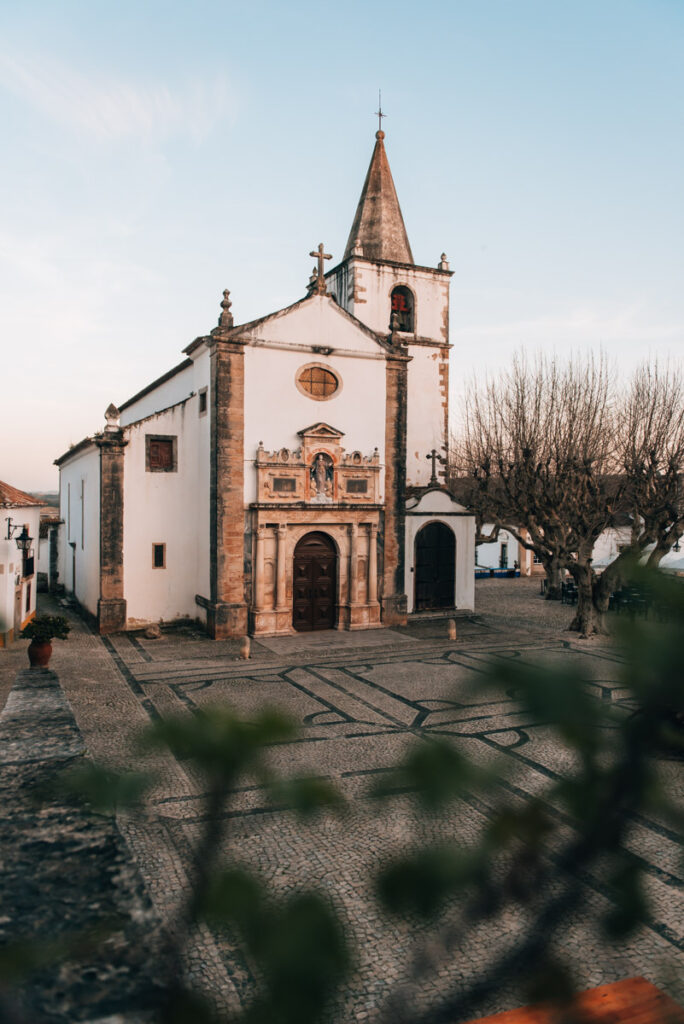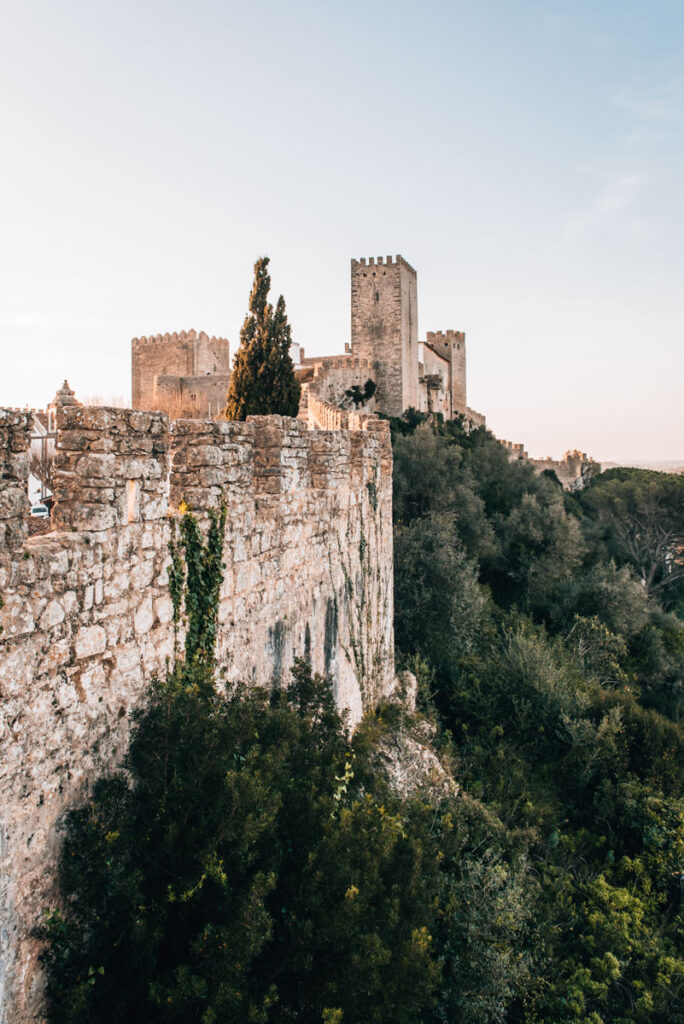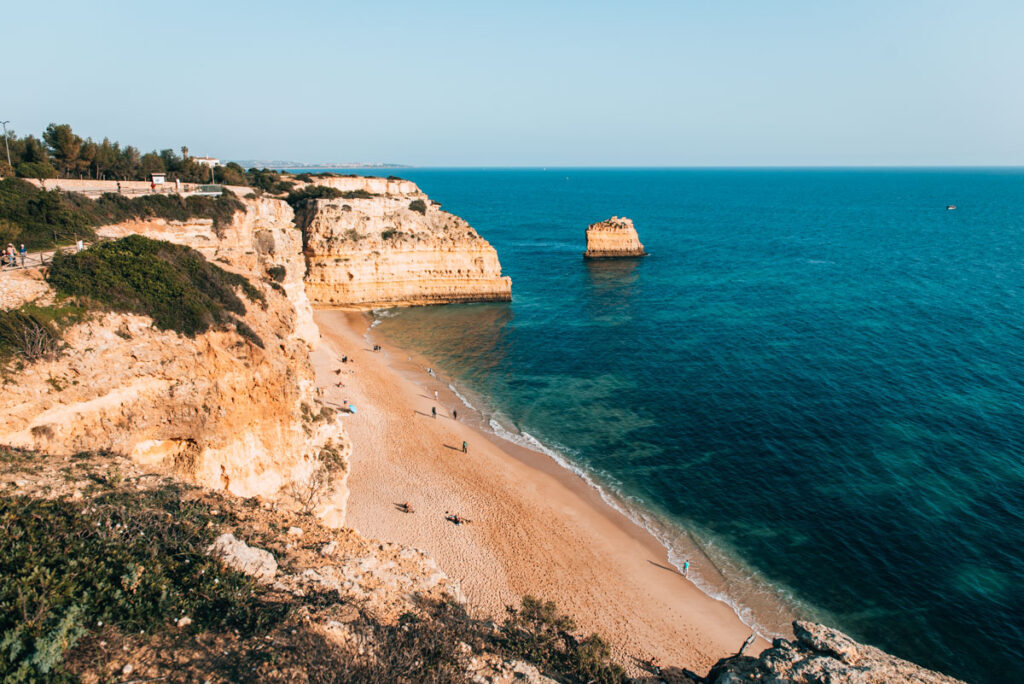Welcome to Óbidos, one of Portugal’s best-preserved medieval towns! If you’re looking to step back in time, Óbidos is the ideal destination. Even from afar, the town’s majestic presence atop a hill is captivating.
As beautiful as Óbidos is, it’s quite touristy (as expected). However, we still think a visit to Óbidos is definitely worth it on any trip to Portugal.
Curious about what Óbidos has to offer? In our comprehensive travel guide, we share all the tips you need for a memorable trip. We’ll introduce you to the key attractions, highlight some excellent day trips, and even reveal where we stayed in Óbidos (hint: it’s a hidden gem!). Let’s dive in!


Inhalt
1. Óbidos: First Tips and Info at a Glance
What to Expect in Óbidos
Imagine white houses, cobblestone alleys, and vibrant flower pots at every turn—Óbidos is undeniably one of Portugal’s prettiest towns. As a medieval town, it’s incredibly well-preserved and brimming with stunning sights.
Visiting Óbidos is like a journey back in time. However, its picturesque beauty has transformed it from a hidden gem into a tourist magnet.
Óbidos is about an hour’s drive north of Lisbon. Many visit Óbidos as part of a day trip. However, during our tour of Portugal, we spent two nights near Óbidos and didn’t regret it. This allowed us to explore Óbidos during the much quieter evening hours. There are also several worthwhile day trip destinations around Óbidos, which we will introduce later in this blog post.
Good to Know: Practical Tips for Your Visit to Óbidos
- Óbidos is tiny and can be explored very quickly. (Just to illustrate: You can stroll leisurely from one end of the town to the other in less than 10 minutes.) Still, plan to spend about two to three hours for your visit. This way, you can also take your time walking along the historic town walls.
- Óbidos is very touristy, especially during the peak summer travel season. Our tip: In the evening, when the tour buses have gone, Óbidos is much quieter. That’s why we decided to stay overnight in the area. You’ll find our accommodation tip further down in this blog post.
- Parking is straightforward on one of the two large car parks located right at the entrance to the old town. The old town of Óbidos itself is closed to regular car traffic.
- Although there aren’t long distances to cover in Óbidos, sturdy footwear is highly recommended (think cobblestones). This is especially important for those who want to venture onto the historic town walls.



2. Óbidos Travel Guide: Best Attractions and Our Tips
In this section of our travel guide, we outline the key attractions in Óbidos, listed in the order of visit so you can follow our exact route around the town.
City Gate (Porta da Vila)
The first attraction awaits right after the car park. The historic city gate of Óbidos, officially called Porta da Senhora da Piedade, is the main entrance to the old town of Óbidos.
At first glance, the gate might seem like a simple city entrance, but once you walk through the arch, a beautiful passage awaits you, decorated – typically Portuguese – with ornate tiles (Azulejos). There’s also a small chapel inside the city gate.

Rua Direita
Once you’ve passed through the city gate, you’re right in the middle of it: To your left begins Rua Direita. This is essentially the main street of Óbidos’ medieval town centre and leads directly to the castle.
The street is lined with souvenir shops and small stores where you can taste and buy Ginja, a sweet cherry liqueur that’s a speciality of Óbidos.
Especially during peak tourist season, Rua Direita can get quite crowded. A little tip: It’s definitely worth veering off into the side streets now and then. They’re usually much quieter.

Igreja de Santa Maria
After a few minutes on Rua Direita, you’ll find the Igreja de Santa Maria on your right. It’s situated on a pretty, relatively spacious square and is the most important church in Óbidos.
An interesting detail: The church was originally built as a mosque. It’s well worth taking a look inside. The walls of the church are adorned with traditional blue-and-white Azulejos.

Castle of Óbidos
At the northern end of Rua Direita, you’ll reach one of the most significant landmarks of Óbidos: the medieval fortress known as Castelo de Óbidos.
The current castle dates back to the 13th century. With its prominent towers, the castle is visible from afar and dominates the skyline of Óbidos. You can view it from the outside, but it’s not open for exploration inside, as it now houses a hotel.

Town Walls of Óbidos
Last but not least: One of the most famous attractions of Óbidos is its historic town wall, the Muro de Óbidos. It encircles the medieval town centre for about 1.5 kilometers.
What’s special about this town wall is that you can walk on it. If you’re thinking this sounds like a leisurely activity, think again: The wall is unguarded on one side over long stretches, making it definitely not suitable for those with a fear of heights. In some places, the wall reaches a dizzying height of 13 meters!
But not to worry: If you’re sure-footed and looking for a bit of a thrill, it’s definitely an adventure worth trying. In most places, the wall is about one meter wide, so there’s plenty of room. However, we wouldn’t recommend taking small children up there.
There are several access points to the historic town wall. For example, you can start right at the city gate (Porta da Vila).



3. Tips for Day Trips Around Óbidos
Planning to stay in Óbidos for more than just a day trip? Good decision – we’d definitely recommend it. In this section, we share our tips for side trips near Óbidos.
Nazaré
About a 30-minute drive north of Óbidos is the legendary surf spot, Nazaré. Perhaps you’ve seen a photo of a giant wave in Portugal? It was likely taken here, as Nazaré is famous for its “Big Waves”.
Attractions and Tips for Your Visit to Nazaré
Nazaré is split into two parts: Down at the beach is the old fishing quarter with its cafes and eateries. Perched atop the hill is the upper town, Sitio. You’ll need to head up there (either by car or funicular) if you want to catch a glimpse of the famous monster waves at Praia do Norte.
From the car park near the church, a roughly 15-minute paved path leads down to the lighthouse. Along the way, you’ll get fantastic views to your left of Nazaré and to your right of Praia do Norte.
Once at the lighthouse, you can visit the small surf museum located within the old fort. Personally, we think the place could be better maintained, but the view from the top is certainly impressive.
Important Tip: The Big Waves are only visible in winter, roughly between November and February, and only when the weather conditions are right! If it’s important to you to see these waves, it’s best to check the forecast in advance, for example on www.nazarewaves.com. (We saw only medium-sized waves. We knew this beforehand but decided to visit anyway.)
We also made a stop in the old fishing quarter down at the beach. A little tip if you’re hungry: The Village Brunch & Coffee offers a solid breakfast/lunch at fair prices.





Alcobaça
You can reach the small town of Alcobaça from Óbidos in about 30 minutes by car. What can you expect here? One of Portugal’s most famous structures, the Mosteiro de Alcobaça. It has been a UNESCO World Heritage Site since 1989. For anyone looking for a culturally enriching day trip from Óbidos, this is the place to be.
This remarkable former Cistercian monastery dates back about 900 years. The sheer scale of the monastery is striking. You’ll truly appreciate its vastness when you step inside the relatively modest interior of the church.
You can explore the Alcobaça Monastery on your own. During your tour, you will pass by the highly impressive cloister and the monastery kitchen, among other highlights.
Little Tip: It’s a good idea to combine your visits to Nazaré and Alcobaça, as both places are only 15 minutes apart by car.



Peniche & Berlengas
The coastal town of Peniche, like Nazaré, is a famous surf spot. You can reach Peniche from Óbidos in just under 30 minutes by car.
Peniche is situated on a rocky peninsula. The town itself doesn’t boast major landmarks – the focus here is more on the coastal landscape and the beaches.
Peniche is also the starting point for exploring the Berlengas – a rugged, spectacular archipelago. A tour there is often the highlight for many visitors to the Peniche area. Here you’ll also find one of the most iconic photo spots: the fortress of São João Baptista.
The Berlengas are about 11 kilometers off the mainland. Boats depart from the harbour in Peniche. It’s important to note that due to the rough seas, you can only visit the Berlengas from May to September.

4. Our Accommodation Tip for Óbidos
As we mentioned earlier, we strongly recommend staying near Óbidos to fully enjoy the town. While staying right in the medieval town center might seem appealing, we have a better suggestion: the beautiful Cavalo di Madeira.
Located about a 10-minute drive from Óbidos in a tiny village offering total peace and quiet, Cavalo di Madeira is an accommodation where great emphasis is placed on sustainability. This starts with the architecture (which incorporates a lot of natural materials like cork) and extends to the excellent breakfast made from regional organic products.
With only three rooms, Cavalo di Madeira ensures a personal, family-like atmosphere. From the moment you arrive, you’ll feel at ease. The lovely garden and the stunning views of the Óbidos Lagoon from our room, combined with the warm hospitality of the staff, make this place truly special.
You can book your stay here: Cavalo di Madeira



Disclaimer: Affiliate Links
This travel guide contains our personal recommendations in the form of affiliate links. If you book or buy something through these links, we earn a small commission at no extra cost to you. A massive thank you from us both!
Have you visited Óbidos too? How did you like the medieval town? Would you like to add any more tips for Óbidos? We’d love to hear from you in the comments below this travel guide.


